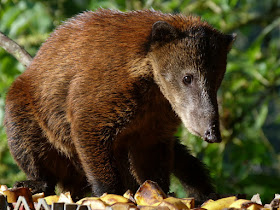Here is the third - and for now at least the last, though there is another in the offing - in this instalment of the occasional series on colours in nature. Starting here I've been looking at shades usually referred to as reddish-brown, rufous, copper, chestnut, rusty and other evocative appellations, looking first at some birds and more recently at mammals.
I have more rusty birds to share with you at some stage, but I want to give the too-often ignored players, invertebrates and reptiles, a starring role before you get bored with this topic.
Given the common origins of feathers and fur in scales, it seems reasonable to assume that the same phaeomelanins that produce these earthy colours in birds and mammals are found in reptile scales, but I doubt that much work has been done on the subject. Looking at some of my pictures of Australian desert lizards, it struck me how logical it was to employ rusty tones, as they match those of the iron-infused sands and stones they often inhabit.
 |
| Central Bearded Dragon Pogona vitticeps, near Coober Pedy, South Australia. |
 |
| Spotted Military Dragon Ctenophorus maculatus, near Cue, central Western Australia. |
 |
| Ctenotus brooksi Kata Tjuta NP, central Australia. This is one of dozens of members of this genus, many of them desert-dwellers. |
On the other hand it seems there can be a point in being a rich bronze colour even if you live in tropical rainforest.
 |
| Hitherto unidentified (ie by me!) skink, Lacy Creek Reserve near Mission Beach, north Queensland. Any suggestions welcomed. |
One Australian reptile group (of three species) actually bears the name copperhead, but ironically I've rarely seen these snakes with such an adornment. On the other hand, this very handsome Lowland Copperhead Austrelaps superbus, crossing the road in Tasmania had a lovely glossy coppery body.
 |
| Lowland Copperhead, Bruny Island, southern Tasmania. |
Other snakes, of other groups, also share such tones.
 |
| Anaconda Eunectes murinus, Yasuní NP, Ecuadorian Amazonia. This magnificent animal (whose head is just visible in the centre of the coils) was resting on floating vegetation at the edge of a lake. |
 |
| Striped Bronzeback Tree Snake Dendrelaphis caudolineatus Labuk Bay, Sabah. This elegant colubrid (back-fanged venomous snake) is common in the region. |
And so to some coppery/gingery/etc invertebrates. There are of course many, and this is just a small selection across a range of groups. It is likely that the ubiquitous phaeomelanins play a role here too, but it is also likely that different groups have come up with different pigments, as is the case with other invertebrate colours. I have chosen examples from grasshoppers, beetles, bugs, butterflies, ants, snails and millipedes. As ever, I am unable to identify most of them I'm afraid.
As with the lizards above, camouflage seems to be an important driver in the rusty tones of many Australian desert grasshoppers.
 |
| Grasshopper, Kings Canyon, central Australia. |
 |
| Double Drummer Cicada Thopha saccata, Nowra, New South Wales. It is quite possible that these colours are such an attempt at protection by mimicry; most cicadas are avidly sought by predatory birds. |
 |
| Bullant Myrmecia sp., Currarong, New South Wales. No bluff required here - bullant stings rate very highly on scales of 'sting pain'. |
 |
| Yellow Admiral Vanessa itea Mount Granya NP, Victoria; please bear in mind that I didn't name it! I love the gradation of rich rufous tones. |
 |
| Antanartia sp. (I think) Family Nymphalidae, Bwindi Impenetrable NP Uganda. Again, subtle and rich. |
 |
| This huge snail came out in the rain at Rio Silanche Reserve, north-east of Quito, Ecuador. I don't always think of snails as colourful, but this one certainly qualified. |
And to finish off, another from the Ecuador rainforests, a millipede, a group of animals I always enjoy.
 |
| Millipede, Yasuní NP, Amazonia/ |
I hope you've enjoyed this coppery ride as much as I have; I've come to realise that these tones are high among my favourite colours, and of course any animal is among my favourites!
As previously mentioned I have another list of gingery birds to share with you one day, but perhaps it's time to take a break from the topic and talk about something else - next time I'll be back from warm Borneo in frosty Canberra, talking to you 'live'.
BACK ON WEDNESDAY 1 JUNE













































